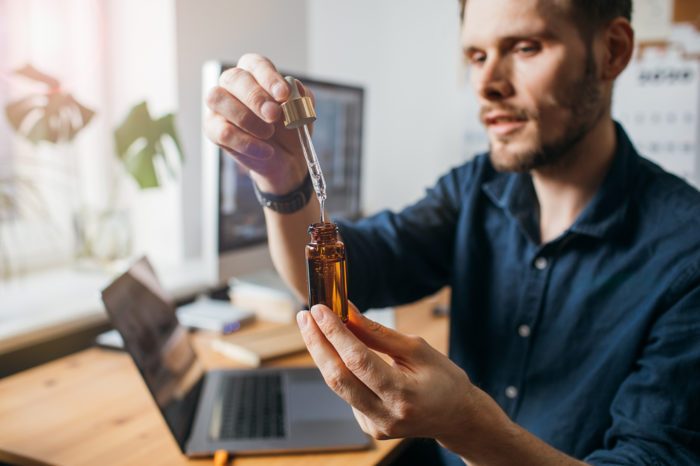Study says potent pain relief with cannabis is not possible for the long term. We say your study is flawed, sir.
Chronic pain is one of the most common reasons patients try cannabis. There is chatter in the research space, however, that too much THC could be counter-productive and even result in increased pain levels. How is that possible? When looking for potent pain relief, it is common to choose a chemovar (strain) with high THC levels.
Further, according to a study [1]Cash, M. C., Cunnane, K., Fan, C., & Romero-Sandoval, E. A. (2020). Mapping cannabis potency in medical and recreational programs in the United States. Plos One, 15(3). doi: … Continue reading published in PLoS One (2020), the growing demand for high THC cannabis is exactly to manage pain. Are we doing this wrong?
What do we Know about Cannabis for Potent Pain Relief?
Medical cannabis is undergoing intense research for dozens, if not hundreds, of different therapeutic applications. But, while the verdict may be out on most of these, the fundamentals of cannabis for pain relief have been known for awhile.
Further, even the National Academies Press concluded, in their pivotal report from 2017, that cannabis works. After an extensive and detailed review of the literature, they stated that, “In adults with chronic pain, patients who were treated with cannabis or cannabinoids are more likely to experience a clinically significant reduction in pain symptoms.”[2]Groce, E. (2018). The Health Effects of Cannabis and Cannabinoids: The Current State of Evidence and Recommendations for Research. Journal of Medical Regulation, 104(4), 32–32. doi: … Continue reading
The question remains, is it THC that is helping? CBD? Other cannabinoids?
How to Cannabinoids Help With Symptoms of Pain?
The two most researched cannabinoids, THC and CBD, are known to give significant pain relief fro the animal body. While scientists might not completely understand the therapeutic channels of each cannabinoid, yet, it seems clear that they both provide potent pain relief.
Of course, there is no denying THC is intoxicating, and in large doses, may trigger the onset of acute cannabis intoxication. While short-lived, the experience is highly uncomfortable and can cause some to experience heightened anxiety.
So, just how much is enough then? Many studies have determined that the effects of THC and CBD (and presumably other cannabinoids as well) fall onto a dose-dependent, bell-shaped, curve. For example, a tiny dose may not provide any benefits, a medium dose will alleviate the condition, and a larger dose may make the condition worse. This is certainly true for managing the symptoms of many conditions, including stress and mood.
Study Says Cannabis is now ‘Too Potent’ for Pain Relief
Let’s review what the original PLOS ONE study (2020) had to say about potency, pain relief, and medical cannabis.[3]Cash, M. C., Cunnane, K., Fan, C., & Romero-Sandoval, E. A. (2020). Mapping cannabis potency in medical and recreational programs in the United States. Plos One, 15(3). doi: … Continue reading
A team of researchers from North Carolina collected information on more than 8,500 products from legal medical and recreational retailers. The paper, “Mapping cannabis potency in medical and recreational programs in the United States,” evaluated both the CBD and the THC potency of the products as advertised on dispensary websites. They ended up drawing comparisons between the strengths from recreational markets with those of medical ones.
The authors hypothesized, “that the potency of medical cannabis that is advertised online is similar to the cannabis advertised for recreational purposes, which would potentially create a misconception towards medical cannabis.”
Through their further data analysis, the researchers concluded that a majority of strains from both sectors had over fifteen percent potency. They also determined that both recreational and medicinal products had similar potencies of THC.
As such, they came to the conclusion that, “These stated concentrations seem unsuitable for medicinal purposes, particularly for patients with chronic neuropathic pain. Therefore, this information could induce the misconception that high potency cannabis is safe to treat pain.”
Getting to the Truth of the Matter on Cannabis for Pain
The study has many issues. The authors seem to be connecting dots that are not really possible to connect. To begin, by only assessing advertised potencies, how can they conclude medicinal effectiveness, or patient assumptions?
First, they did not test any of the samples contained within the data analysis. That means they cannot confirm if the potencies advertised match the real-potency of the product. As several reports have unfortunately already confirmed, the cannabis industry doesn’t always get reported cannabinoids right.
The second issue with this study is the assumption that there is an ideal potency for the treatment of pain among all pain patients. Their assumption that fifteen percent THC is too much for therapeutic impact fails to take into consideration tolerance, gender, age, physiology, and other influences of the individual dose-response of a pain patient.
As Dr. Dustin Sulak wrote in a piece for Leafly, “I’ve seen adult patients achieve therapeutic effects at 1 mg of total cannabinoids daily, while others consume over 2,000 mg daily without adverse effects.” Sulak explains, “Within this unusually broad dosing range, cannabis exhibits an unusual relationship between the dose and the expected response.”
With what we know about the range of dose-response in one patient to another, the authors are incorrect in their assumption that a higher dose of THC is ineffective for all pain patients. For some, potent pain relief might only come with high doses of THC.
THC Levels in Studies are Low
The study published in PLOS ONE relied on several pain studies to conclude that higher potency cannabis was not effective for pain relief. Yet in every single one of these sources, the maximum dose tested was only eight percent. This is largely due to the fact that research cannabis in America comes from the same source and this source believes that eight per cent THC is the upper limit for suitable cannabis. In fact, some were as low as three percent.
Examples of Studies PLOS ONE Consulted
- In “Efficacy of Inhaled Cannabis on Painful Diabetic Neuropathy,” researchers tested up to seven percent THC.[4]Wallace, M. S., Marcotte, T. D., Umlauf, A., Gouaux, B., & Atkinson, J. H. (2015). Efficacy of Inhaled Cannabis on Painful Diabetic Neuropathy. The Journal of Pain, 16(7), 616–627. doi: … Continue reading
- For “Low-dose vaporized cannabis significantly improves neuropathic pain,” the maximum dose was 3.53 percent THC.[5]Wilsey, B., Marcotte, T., Deutsch, R., Gouaux, B., Sakai, S., & Donaghe, H. (2013). Low-Dose Vaporized Cannabis Significantly Improves Neuropathic Pain. The Journal of Pain, 14(2), 136–148. … Continue reading
- Meanwhile in “Dose-dependent effects of smoked cannabis on capsaicin-induced pain and hyperalgesia in healthy volunteers,” the highest potency was eight percent THC.[6]Wallace, M., Schulteis, G., Atkinson, J. H., Wolfson, T., Lazzaretto, D., Bentley, H., … Abramson, I. (2007). Dose-dependent Effects of Smoked Cannabis on Capsaicin-induced Pain and Hyperalgesia in … Continue reading
- Lastly, “Effects of moderate and high doses of marihuana on thermal pain: a sensory decision theory analysis,” the supposedly ‘high’ dose was only two percent THC. [7]Clark, W. C., Janal, M. N., Zeidenberg, P., & Nahas, G. G. (1982). Effects of moderate and high doses of marihuana on thermal pain: a sensory decision theory analysis. Pain, 14(2), 202–203. … Continue reading
Therefore, their hypothesis is based on a body of work that entirely excludes products with over ten percent THC. This is extremely problematic in the world of research.
Other Methodological Questions not Answered
Other questions also need asking, well beyond what can be tackled here. For example, did the participants in the research have any experience with cannabis? Did they use cannabis from federal cultivation facilities, which lack the variety and potencies seen in the market? Moreover, do different kinds of pain respond to different potencies? Do different demographics (age, gender, etc.) respond to different potencies?
Misguided Conclusions on the Potent Pain Relief of Cannabis
The data analysis of the advertised potencies of 8,500 cannabis samples, while valuable, is not enough information to make most of the assumptions that were published. The research failed to speak to patients, did not test samples to verify cannabinoid concentrations, and excluded valuable research on cannabis for pain.
Of course, patients consuming cannabis for chronic pain should always follow a careful self-titration protocol when testing how much cannabis is needed to manage their pain, but should settle on a dose that works for them. This is the beauty of cannabis as a personalized medicine. There are different strains with different terpene profiles and cannabinoid concentrations. Further, the potency of THC can be affected by any of these relationships.
References







